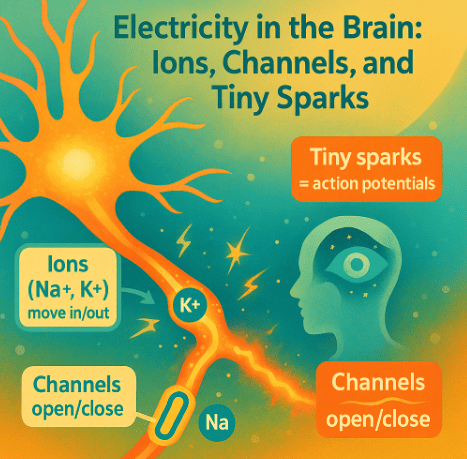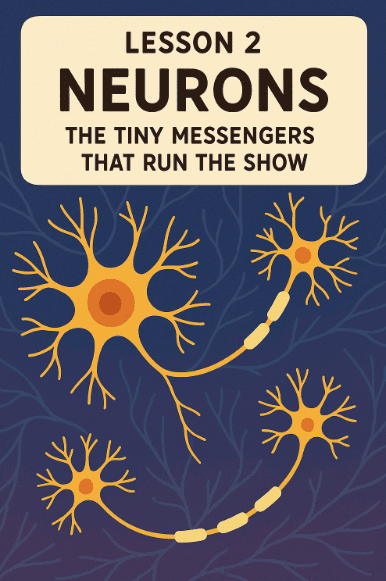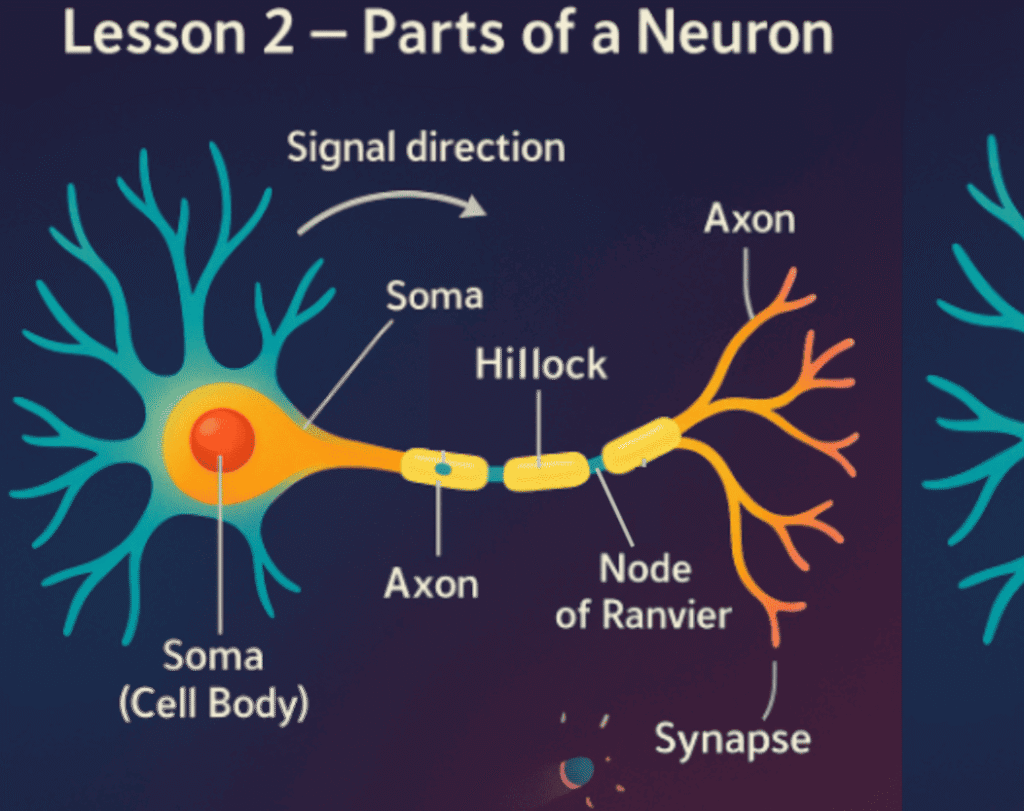
Quick Recap of Where We Are
In the last lesson, we asked one of the deepest questions ever: Do we truly have free will, or is our brain just running on chemistry like a machine? We explored how brain chemicals shape choices, how emotions influence decisions, and how scientists debate whether we are in charge of our own actions.
Now we shift gears. To understand how the brain even works moment to moment, we need to peek into the electrical side of the brain. If you’ve ever wondered:
-
How do billions of brain cells talk to each other?
-
How can a thought travel across the brain in less than a second?
-
Why is the brain sometimes called an “electric organ”?
…then you’re about to find out.
Step 1: Electricity Is Not Just Wires in the Wall ⚡🔌
When we hear the word electricity, most of us think about light bulbs, phone chargers, or lightning bolts. But the brain also runs on electricity—just in a very different way.
In your home, electricity flows because electrons (tiny negatively charged particles) move through metal wires.
In your brain, it’s not electrons running down wires, but ions moving in and out of cells.
👉 Ion means an atom (tiny particle of matter) that has gained or lost an electron, so it has a charge.
If it has lost an electron, it’s positively charged (like sodium, Na⁺, or potassium, K⁺). If it has gained an electron, it’s negatively charged (like chloride, Cl⁻).
Think of ions as little charged marbles floating in salty brain water. These marbles can rush in and out of brain cells, and that rushing creates tiny sparks of electricity.
Step 2: Meet the Brain’s Wires – Neurons 🧩

We met neurons before, but let’s remind ourselves. A neuron is a special cell in the brain that can send and receive signals. Each neuron looks like a tree:
-
The dendrites are like branches that catch signals.
-
The cell body (soma) is like the trunk where decisions are made.
-
The axon is like a long cable that carries the signal far away.
-
The axon terminals are like tiny roots that pass the signal to the next neuron.
But here’s the secret: signals in neurons don’t travel by shouting words. They travel as electrical impulses – tiny zaps created by the movement of ions.

Step 3: Resting Potential – The Charged Battery of the Brain 🔋
Right now, even as you sit and read this, every neuron in your brain is quietly “charged up” like a little battery. Scientists call this the resting potential.
At rest, the inside of a neuron is more negative than the outside. Imagine the neuron as a tiny water balloon filled with salty water.
-
Outside the balloon: lots of sodium ions (Na⁺).
-
Inside the balloon: lots of potassium ions (K⁺) and large negatively charged proteins.
Because of this arrangement, the inside is about -70 millivolts (mV) compared to the outside.
👉 A millivolt is just one-thousandth of a volt. A normal AA battery has 1.5 volts, so -70 mV is tiny. But in the world of neurons, it’s huge.
This difference in charge between inside and outside is like a loaded spring. It’s waiting to be released.
Step 4: The Channels – Brain’s Electric Gates 🚪
How do ions move? They can’t just drift through the neuron’s wall. The wall (membrane) is picky. It only lets ions through special ion channels.
👉 Ion channel = a protein “door” in the neuron’s membrane that opens and closes to let ions in or out.
There are many types of channels:
-
Sodium channels let Na⁺ in.
-
Potassium channels let K⁺ out.
-
Chloride channels let Cl⁻ move.
Some channels are like automatic doors that open when a certain voltage is reached. Others are like doors with locks, opening only if the right chemical key (a neurotransmitter) is present.
So the neuron is like a castle with gates, and the ions are like villagers rushing in and out when the gates open.
Step 5: Action Potential – The Spark of Thought ✨
When a neuron decides to send a message, it creates an action potential. This is the famous electrical “spike” that neuroscientists love to measure.
Here’s how it works:
-
A signal from another neuron makes sodium channels open.
-
Sodium (Na⁺) rushes in, because there’s more outside than inside. Suddenly, the inside becomes less negative.
-
If the charge rises from -70 mV to about -55 mV (the “threshold”), BOOM! The neuron fires.
-
A wave of sodium rushing in zips down the axon like dominoes falling.
-
Then potassium channels open, letting K⁺ rush out, restoring the negative charge.
-
The neuron resets, ready to fire again.
👉 This action potential lasts just a few milliseconds (thousandths of a second), but it can travel along an axon at up to 120 meters per second (almost the speed of a race car!).
That’s how thought becomes fast.
To put it simply, here’s the step-by-step process of how action potential occurs:
-
Neuron at rest: inside is -70 miliVolt
-
Sodium channels open, Na⁺ rushes in
-
Threshold is reached, action potential starts
-
Wave of depolarization travels down the axon
-
Potassium channels open, K⁺ rushes out
-
Neuron resets back to resting potential
Step 6: The Myelin Boost – Brain’s Insulation 🧤
Some axons are wrapped in a fatty coating called myelin. This works just like the plastic insulation on electrical wires. It keeps the signal from leaking out and makes it travel faster.
Instead of flowing smoothly, the action potential “jumps” between gaps in the myelin called nodes of Ranvier. This is called saltatory conduction (from the Latin saltare, “to jump”).
That’s why signals in myelinated neurons move much faster. Diseases like multiple sclerosis damage myelin, and then signals slow down or get lost, causing movement and thinking problems.
Step 7: Putting It Together – A Spark Becomes a Thought 🌟
So when you think of a word, move your hand, or remember a song, what’s really happening? Millions of neurons are firing action potentials, with sodium rushing in, potassium rushing out, and little sparks zipping across axons.
It’s like a giant stadium where each fan has a flashlight. One person turning on their light may not matter, but when thousands do it in sequence, a wave sweeps across the stadium. That’s what happens in your brain every second.
Step 8: Why Brain Electricity Matters 💡
Why should we care about all this detail? Because this is the foundation of everything the brain does.
-
Learning happens because repeated sparks strengthen connections.
-
Memory depends on patterns of electrical activity.
-
Diseases like epilepsy are caused by runaway electrical storms in the brain.
-
Even feelings like love or fear begin as ion movements that trigger bigger brain circuits.
Without electricity, the brain is just a lump of soft tissue. With electricity, it becomes a thinking, dreaming, remembering machine.
Final Recap 📝
Today we saw that electricity in the brain doesn’t come from wires but from ions—tiny charged particles—moving through special gates called ion channels. A neuron at rest is like a charged battery at -70 mV.
When enough sodium rushes in, the neuron fires an action potential, a tiny spark that zips along its axon.
Myelin makes the signal faster, like insulation on a wire. Together, billions of these sparks create every thought, memory, feeling, and action you’ve ever had.
Next time, we’ll look at the brain’s messengers: neurotransmitters—the chemicals that let one neuron talk to the next.